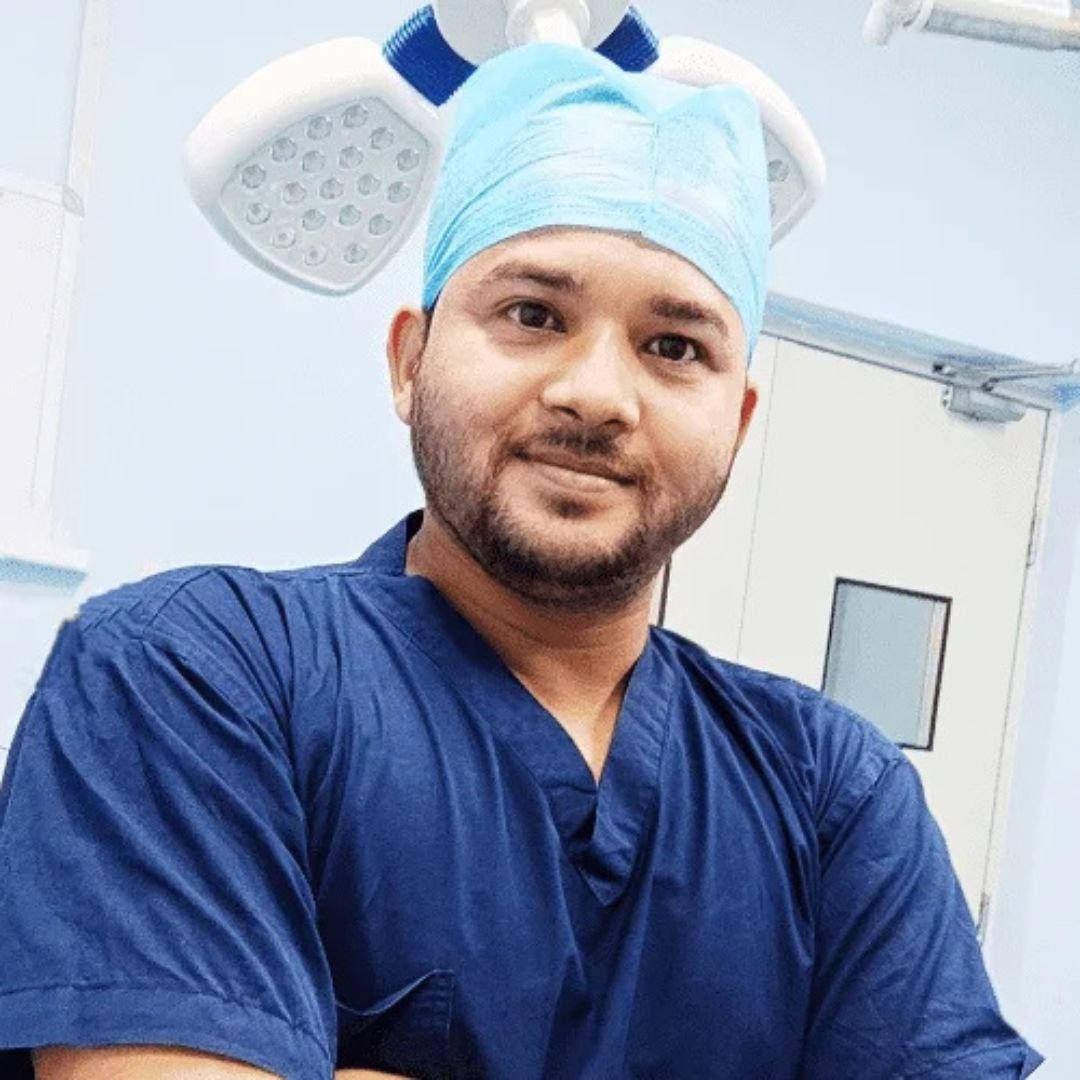Uterine Fibroids Treatment - Symptoms, Diagnosis, and Advanced Treatment Options
Uterine fibroids are non-cancerous growths that develop in or around the uterus. They are one of the most common gynecological conditions, affecting millions of women worldwide. While many women with uterine fibroids may not experience symptoms, others may face severe discomfort, heavy menstrual bleeding, and reproductive challenges. At Bharatkare, we provide advanced and personalized treatment options for uterine fibroids, ensuring effective relief and improved quality of life. If you’re experiencing symptoms or have been diagnosed with uterine fibroids, consult our experts to explore the best treatment options tailored to your needs.
Book Appointments With Our Expert Doctors Near You
- Get consultation for 50+ diseases across India
- In-person and online consultation with experienced doctors
- Extensive medical assistance throughout your treatment


Dr Ashish Sachdeva
MBBS, MS - General Surgery, General Surgeon, Bariatric Surgeon, Laparoscopic Surgeon
4.9/5
20 Years Experience
Vadodara, India

Dr. Tanmay Jain
General Surgeon, Laparoscopic Surgeon and Proctologist
4.9/5
12 Years Experience
Jaipur, India

Dr. Vikram Vasuniya
MBBS, MS (General Surgery) General Laparoscopic & Laser Surgeon, Laser Proctologist
4.9/5
14 Years Experience
Bhopal, India

Dr. Sujeet Kumar Bharti
MBBS, MS (General Surgery) General Laparoscopic & Laser Surgeon, Laser Proctologist
4.9/5
22 Years Experience
Patna, India
What Are Uterine Fibroids?
Uterine fibroids, also known as leiomyomas or myomas, are benign tumors that grow in the muscular wall of the uterus. They can vary in size, ranging from as small as a seed to as large as a grapefruit. Fibroids are classified based on their location in the uterus, which plays a significant role in determining the symptoms and treatment options.
- Types of Uterine Fibroids:
- Subserosal Fibroids: These fibroids grow on the outer wall of the uterus.
- Intramural Fibroids: Found within the muscular wall of the uterus, these are the most common type.
- Submucosal Fibroids: These develop just under the lining of the uterine cavity and can cause heavy bleeding and fertility issues.
- Pedunculated Fibroids: These fibroids are attached to the uterus by a stalk and can grow either inside or outside the uterus.
- Uterine Fibroid Classification:
Fibroids are also classified based on their size and number. The uterine fibroid size chart helps doctors determine the severity of the condition and plan the appropriate treatment.
Disease name
Uterine Fibroids
Surgery name
Myomectomy Surgery
Duration
2 Hours
Treated by
Obstetrician/Gynecologist or a gynecologic oncologist
Symptoms of Uterine Fibroids
The symptoms of uterine fibroids can vary depending on their size, location, and number. Some women may remain asymptomatic, while others may experience:
- Heavy or prolonged menstrual bleeding (menorrhagia).
- Pelvic pain or pressure.
- Frequent urination or difficulty emptying the bladder.
- Pain during intercourse.
- Irregular periods or spotting between periods.
- Enlargement of the lower abdomen.
- Can uterine fibroids cause irregular periods? Yes, they can disrupt the menstrual cycle, leading to irregular or painful periods.
If you experience any of these symptoms, it’s essential to consult a healthcare provider for a proper diagnosis and treatment plan.
Causes and Risk Factors of Uterine Fibroids
The exact cause of uterine fibroids is unknown, but several factors contribute to their development:
- Hormonal Imbalance: Estrogen and progesterone, the hormones that regulate the menstrual cycle, can promote the growth of fibroids.
- Genetic Predisposition: A family history of fibroids increases the likelihood of developing them.
- Age: Women in their 30s and 40s are more likely to develop fibroids.
- Obesity: Excess body weight is associated with a higher risk of fibroids.
- Diet: A diet high in red meat and low in green vegetables may increase the risk.
Understanding these risk factors can help in managing and preventing the growth of fibroids.
How Are Uterine Fibroids Diagnosed?
Diagnosing uterine fibroids involves a combination of medical history, physical examination, and imaging tests. Here’s an overview of the diagnostic process:
- Medical History and Physical Examination:
Your doctor will ask about your symptoms, menstrual cycle, and medical history. A pelvic exam may be conducted to check for abnormalities in the shape and size of the uterus. - Ultrasound (Uterine Fibroid USG):
A uterine fibroid USG is the most common imaging test used to detect fibroids. It provides detailed images of the uterus and helps identify the size, location, and number of fibroids. - Magnetic Resonance Imaging (MRI):
An MRI is used for a more detailed evaluation, especially in complex cases or when planning surgery. - Hysterosonography:
This test involves injecting saline into the uterine cavity to enhance ultrasound images, particularly useful for diagnosing submucosal fibroids. - Hysteroscopy:
A hysteroscope (a thin, lighted tube) is inserted through the cervix to examine the inside of the uterus. - Laparoscopy:
This minimally invasive procedure allows the doctor to view the uterus and surrounding structures directly.
Uterine Fibroid Degeneration and Calcification
- Uterine Fibroid Degeneration:
Fibroids can outgrow their blood supply, leading to degeneration. This process can cause sudden, severe pain and is often associated with pregnancy. Degenerated fibroids may shrink over time but can still cause symptoms. - Calcified Uterine Fibroid:
In some cases, fibroids may calcify, especially in postmenopausal women. Calcified fibroids are hard and can be detected through imaging tests like X-rays or ultrasounds.
Can Uterine Fibroids Go Away on Their Own?
In some cases, uterine fibroids may shrink on their own, especially after menopause when estrogen levels decline. However, this is not guaranteed, and many women require treatment to manage symptoms and prevent complications.
Difference Between Uterine Fibroid and Uterine Cancer
It’s essential to differentiate between uterine fibroids and uterine cancer, as their treatment approaches are entirely different.
- Uterine Fibroids: Benign growths that do not spread to other parts of the body.
- Uterine Cancer: Malignant growths that can invade nearby tissues and spread to other organs.
Imaging tests and biopsies are used to confirm the diagnosis and rule out cancer.
Uterine Fibroids ICD 10 Code
The ICD-10 code for uterine fibroids is D25. This code is used for medical billing and documentation purposes.
Treatment Options for Uterine Fibroids
The treatment for uterine fibroids depends on the severity of symptoms, the size and location of the fibroids, and the patient’s reproductive goals. Here’s an overview of the available treatment options:
- Non-Surgical Treatments:
- Medications: Hormonal therapies, such as birth control pills or GnRH agonists, can help manage symptoms.
- Uterine Fibroid Embolization (UFE): A minimally invasive procedure that blocks the blood supply to the fibroids, causing them to shrink.
- Laser Treatment for Uterine Fibroids: A non-invasive option that uses laser energy to destroy fibroid tissue.
- Surgical Treatments:
- Myomectomy: Surgical removal of fibroids while preserving the uterus.
- Hysterectomy: Complete removal of the uterus, often recommended for women who do not wish to conceive.
- Natural and Alternative Treatments:
- Uterine Fibroids Diet: A diet rich in fruits, vegetables, and whole grains can help manage symptoms.
- Herbal Remedies: Some herbs, like green tea and turmeric, may help reduce inflammation and fibroid growth.
Uterine Fibroid Radiology
Radiology plays a crucial role in diagnosing and treating uterine fibroids. Advanced imaging techniques, such as MRI and ultrasound, help in precise localization and treatment planning.
Uterine Fibroid Embolization Cost in India
The cost of uterine fibroid embolization in India varies depending on the hospital, location, and complexity of the case. For accurate pricing, consult our experts at Bharatkare.
Uterine Fibroids Treatment - Exploring Advanced Treatment Options
Uterine fibroids can significantly impact a woman’s quality of life, but with advancements in medical technology, there are several effective treatment options available. At Bharatkare, we offer a range of treatments tailored to your specific needs, whether you’re looking for non-invasive solutions or surgical interventions. In this section, we’ll explore the various treatment options in detail, including their benefits, risks, and suitability for different cases.
Non-Surgical Treatments for Uterine Fibroids
Non-surgical treatments are often the first line of defense, especially for women who wish to preserve their fertility or avoid invasive procedures. Here are some of the most effective non-surgical options:
- Medications:
- Hormonal Therapies: Birth control pills, progesterone-releasing IUDs, and GnRH agonists can help regulate menstrual cycles and reduce heavy bleeding.
- Tranexamic Acid: This medication helps reduce heavy menstrual bleeding by promoting blood clotting.
- NSAIDs: Nonsteroidal anti-inflammatory drugs can help alleviate pain and discomfort associated with fibroids.
- Uterine Fibroid Embolization (UFE):
- Procedure: UFE is a minimally invasive procedure where small particles are injected into the blood vessels supplying the fibroids, blocking their blood flow and causing them to shrink.
- Benefits: No surgical incisions, shorter recovery time, and preservation of the uterus.
- Risks: Temporary pain, fever, and a small risk of infection.
- Laser Treatment for Uterine Fibroids:
- Procedure: Laser energy is used to target and destroy fibroid tissue without damaging surrounding healthy tissue.
- Benefits: Non-invasive, minimal downtime, and effective for small to medium-sized fibroids.
- Risks: May require multiple sessions, and not suitable for large fibroids.
- MRI-Guided Focused Ultrasound Surgery (MRgFUS):
- Procedure: High-intensity ultrasound waves are used to heat and destroy fibroid tissue under MRI guidance.
- Benefits: Non-invasive, no hospital stay, and quick recovery.
- Risks: Limited effectiveness for large fibroids and potential for regrowth.
Surgical Treatments for Uterine Fibroids
For women with severe symptoms or large fibroids, surgical treatments may be necessary. Here’s a detailed look at the surgical options:
- Myomectomy:
- Procedure: Surgical removal of fibroids while preserving the uterus. It can be performed via laparoscopy, hysteroscopy, or open surgery, depending on the size and location of the fibroids.
- Benefits: Preserves fertility and provides relief from symptoms.
- Risks: Risk of fibroid recurrence and potential for scarring.
- Hysterectomy:
- Procedure: Complete removal of the uterus, often recommended for women who do not wish to conceive or have severe symptoms.
- Benefits: Permanent solution with no risk of fibroid recurrence.
- Risks: Infertility, longer recovery time, and potential for surgical complications.
- Endometrial Ablation:
- Procedure: The lining of the uterus is destroyed to reduce menstrual bleeding. This is not a treatment for fibroids but can help manage symptoms.
- Benefits: Minimally invasive and quick recovery.
- Risks: Not suitable for women who wish to conceive and may not be effective for large fibroids.
Uterine Fibroid Embolization (UFE) vs. Myomectomy
Aspect | Uterine Fibroid Embolization (UFE) | Myomectomy |
Invasiveness | Minimally invasive | Invasive (laparoscopic or open) |
Recovery Time | 1-2 weeks | 4-6 weeks |
Fertility Preservation | Possible | Preserves fertility |
Effectiveness | Effective for multiple fibroids | Best for large or symptomatic fibroids |
Risks | Pain, infection, fibroid regrowth | Scarring, fibroid recurrence |
Laser Treatment for Uterine Fibroids vs. Hysterectomy
Aspect | Laser Treatment | Hysterectomy |
Invasiveness | Non-invasive | Invasive |
Recovery Time | 1-2 days | 6-8 weeks |
Fertility Preservation | Possible | Not possible |
Effectiveness | Effective for small to medium fibroids | Permanent solution |
Risks | Multiple sessions may be required | Surgical complications, infertility |
Uterine Fibroids Diet and Lifestyle Changes
While diet and lifestyle changes cannot cure uterine fibroids, they can help manage symptoms and reduce the risk of fibroid growth. Here are some recommendations:
- Uterine Fibroids Diet:
- Foods to Include:
- Fruits and vegetables rich in antioxidants.
- Whole grains like oats, brown rice, and quinoa.
- Lean proteins such as fish, chicken, and legumes.
- Healthy fats like avocados, nuts, and olive oil.
- Foods to Avoid:
- Red meat and processed foods.
- High-sugar and high-fat foods.
- Alcohol and caffeine.
- Foods to Include:
- Exercise:
Regular physical activity can help regulate hormones and reduce the risk of fibroid growth. Activities like yoga, swimming, and walking are particularly beneficial. - Stress Management:
Chronic stress can exacerbate fibroid symptoms. Practices like meditation, deep breathing, and mindfulness can help manage stress levels.
Uterine Fibroid Size Chart and Treatment Planning
The size of uterine fibroids plays a crucial role in determining the appropriate treatment. Here’s a general guide:
Fibroid Size | Treatment Options |
Small (1-5 cm) | Medications, UFE, laser treatment |
Medium (5-10 cm) | UFE, myomectomy, MRgFUS |
Large (>10 cm) | Myomectomy, hysterectomy |
Uterine Fibroid Radiology in Diagnosis and Treatment
Radiology plays a pivotal role in both diagnosing and treating uterine fibroids. Advanced imaging techniques like ultrasound, MRI, and CT scans help in:
- Accurately locating fibroids.
- Determining their size and number.
- Planning minimally invasive procedures like UFE and MRgFUS.
Uterine Fibroid Embolization Cost in India
The cost of uterine fibroid embolization in India varies depending on factors like the hospital, location, and complexity of the case. On average, the cost ranges between ₹1,50,000 to ₹3,00,000. For an accurate estimate, consult our experts at Bharatkare.
Uterine Fibroids Treatment - Exploring Natural and Alternative Options
While medical and surgical treatments are highly effective for managing uterine fibroids, many women seek natural and alternative options to complement their treatment or manage mild symptoms. At Bharatkare, we believe in a holistic approach to healthcare, which is why we’ve compiled a list of natural remedies and lifestyle changes that can help alleviate symptoms and improve overall well-being. In this section, we’ll explore uterine fibroids natural treatment options, dietary recommendations, and alternative therapies.
Natural Treatments for Uterine Fibroids
Natural treatments focus on reducing symptoms, slowing fibroid growth, and improving overall health. While these methods may not eliminate fibroids entirely, they can provide significant relief for many women.
- Dietary Changes (Uterine Fibroids Diet):
A healthy diet can play a crucial role in managing fibroid symptoms and preventing their growth. Here’s what to include and avoid:- Foods to Include:
- Fruits and Vegetables: Rich in antioxidants and fiber, they help reduce inflammation and regulate hormones.
- Whole Grains: Oats, brown rice, and quinoa support digestive health and prevent constipation.
- Lean Proteins: Fish, chicken, and legumes provide essential nutrients without promoting inflammation.
- Healthy Fats: Avocados, nuts, and olive oil help balance hormones and reduce inflammation.
- Foods to Avoid:
- Red Meat and Processed Foods: These can increase inflammation and estrogen levels.
- High-Sugar Foods: Sugary snacks and beverages can disrupt hormonal balance.
- Alcohol and Caffeine: These can exacerbate symptoms like heavy bleeding and cramping.
- Foods to Include:
- Herbal Remedies:
Certain herbs have been traditionally used to manage fibroid symptoms. Always consult your doctor before trying herbal remedies, as they may interact with medications.- Green Tea: Contains antioxidants that may help shrink fibroids.
- Turmeric: Known for its anti-inflammatory properties, it can reduce pain and inflammation.
- Milk Thistle: Supports liver function, which helps regulate hormone levels.
- Chasteberry (Vitex): Helps balance hormones and reduce menstrual irregularities.
- Exercise and Physical Activity:
Regular exercise can help regulate hormones, reduce stress, and improve blood circulation. Recommended activities include:- Yoga: Poses like the butterfly stretch and pelvic tilts can relieve pelvic pressure.
- Cardio: Walking, swimming, and cycling promote overall health and weight management.
- Kegel Exercises: Strengthen pelvic muscles and improve blood flow to the uterus.
- Stress Management:
Chronic stress can worsen fibroid symptoms by disrupting hormonal balance. Techniques to manage stress include:- Meditation: Helps calm the mind and reduce anxiety.
- Deep Breathing: Promotes relaxation and reduces tension.
- Mindfulness: Encourages staying present and managing emotional stress.
- Acupuncture:
This traditional Chinese medicine technique involves inserting thin needles into specific points on the body to balance energy flow. Some studies suggest acupuncture can help reduce fibroid symptoms like pain and heavy bleeding.
Can Uterine Fibroids Go Away on Their Own?
In some cases, uterine fibroids may shrink or disappear without treatment, especially after menopause when estrogen levels decline. However, this is not guaranteed, and many women require medical intervention to manage symptoms effectively.
Difference Between Uterine Fibroid and Uterine Cancer
It’s essential to differentiate between uterine fibroids and uterine cancer, as their treatment approaches are entirely different.
- Uterine Fibroids: Benign growths that do not spread to other parts of the body.
- Uterine Cancer: Malignant growths that can invade nearby tissues and spread to other organs.
Imaging tests and biopsies are used to confirm the diagnosis and rule out cancer.
Uterine Fibroid ICD 10 Code
The ICD-10 code for uterine fibroids is D25. This code is used for medical billing and documentation purposes.
Uterine Fibroid Radiology in Diagnosis and Treatment
Radiology plays a pivotal role in both diagnosing and treating uterine fibroids. Advanced imaging techniques like ultrasound, MRI, and CT scans help in:
- Accurately locating fibroids.
- Determining their size and number.
- Planning minimally invasive procedures like UFE and MRgFUS.
Uterine Fibroid Embolization Cost in India
The cost of uterine fibroid embolization in India varies depending on factors like the hospital, location, and complexity of the case. On average, the cost ranges between ₹1,50,000 to ₹3,00,000. For an accurate estimate, consult our experts at Bharatkare.
Laser Treatment for Uterine Fibroids
Laser treatment is a non-invasive option that uses laser energy to destroy fibroid tissue. It’s particularly effective for small to medium-sized fibroids and offers benefits like minimal downtime and quick recovery.
Uterine Fibroid Radiology in Diagnosis and Treatment
Radiology plays a pivotal role in both diagnosing and treating uterine fibroids. Advanced imaging techniques like ultrasound, MRI, and CT scans help in:
- Accurately locating fibroids.
- Determining their size and number.
- Planning minimally invasive procedures like UFE and MRgFUS.
Uterine Fibroid Size Chart and Treatment Planning
The size of uterine fibroids plays a crucial role in determining the appropriate treatment. Here’s a general guide:
Fibroid Size | Treatment Options |
Small (1-5 cm) | Medications, UFE, laser treatment |
Medium (5-10 cm) | UFE, myomectomy, MRgFUS |
Large (>10 cm) | Myomectomy, hysterectomy |
Uterine Fibroid Degeneration and Calcification
- Uterine Fibroid Degeneration:
Fibroids can degenerate due to a lack of blood supply, causing sudden pain. This is more common during pregnancy. While degeneration can lead to shrinkage, it may still require medical attention. - Calcified Uterine Fibroid:
Calcification occurs when fibroids harden due to calcium deposits. This is often seen in postmenopausal women and can be detected through imaging tests.
Can Uterine Fibroids Cause Irregular Periods?
Yes, uterine fibroids can disrupt the menstrual cycle, leading to irregular periods, heavy bleeding, or prolonged cycles. If you experience these symptoms, consult your doctor for a proper diagnosis and treatment plan.
Uterine Fibroids Treatment - Frequently Asked Questions (FAQs)
Here are some of the most commonly asked questions about uterine fibroids, their symptoms, diagnosis, and treatment options. These FAQs are designed to address your concerns and provide clarity on this condition.
Conclusion
Uterine fibroids are a common condition that affects many women, but with the right diagnosis and treatment, symptoms can be effectively managed. Whether you opt for non-surgical treatments like uterine fibroid embolization (UFE) or surgical options like myomectomy or hysterectomy, it’s essential to consult with a healthcare professional to determine the best approach for your specific case.
At Bharatkare, we are committed to providing personalized care and advanced treatment options for uterine fibroids. From diagnosis to recovery, our team of experts is here to support you every step of the way. If you’re experiencing symptoms or have been diagnosed with uterine fibroids, don’t hesitate to reach out to us for a consultation.
Key Takeaways
- Uterine fibroids are non-cancerous growths that can cause symptoms like heavy bleeding, pelvic pain, and irregular periods.
- Diagnosis involves imaging tests like ultrasound and MRI.
- Treatment options include medications, UFE, laser treatment, myomectomy, and hysterectomy.
- Natural treatments like dietary changes and exercise can help manage symptoms but may not eliminate fibroids.
- Recovery time varies depending on the treatment, ranging from 1-2 weeks for non-surgical options to 6-8 weeks for surgery.
FAQ
You Can Find All Answers Here
Uterine fibroids are non-cancerous growths that develop in or around the uterus. They are made of muscle and fibrous tissue and can vary in size and location.
Common symptoms include heavy menstrual bleeding, pelvic pain, frequent urination, and irregular periods. Some women may remain asymptomatic.
Yes, uterine fibroids can disrupt the menstrual cycle, leading to irregular periods, heavy bleeding, or prolonged cycles.
Uterine fibroids are benign growths, while uterine cancer is malignant. Diagnostic tests like imaging and biopsies are used to differentiate between the two.
In some cases, fibroids may shrink after menopause due to declining estrogen levels. However, many women require medical or surgical treatment to manage symptoms.
The ICD-10 code for uterine fibroids is D25.
Treatment options include medications, uterine fibroid embolization (UFE), laser treatment, myomectomy, and hysterectomy. The choice depends on the size, location, and severity of symptoms
UFE is a minimally invasive procedure that blocks the blood supply to fibroids, causing them to shrink. It is an effective alternative to surgery for many women.
Yes, natural treatments like dietary changes, herbal remedies, exercise, and stress management can help manage symptoms. However, they may not eliminate fibroids entirely.
Radiology, including ultrasound and MRI, plays a crucial role in diagnosing fibroids and planning treatments like UFE and laser treatment.
Quick Links
Popular Surgeries
Find Us
© Copyright BharatKare 2025. All Right Reserved.



